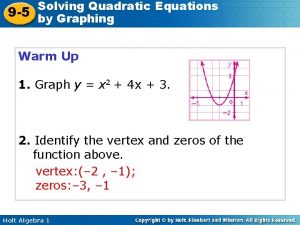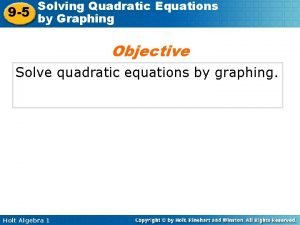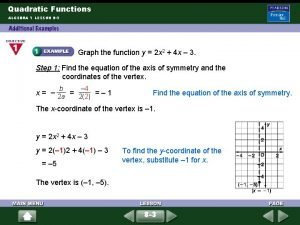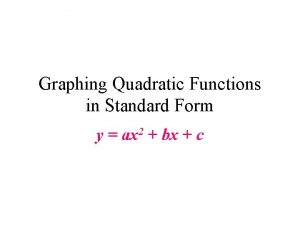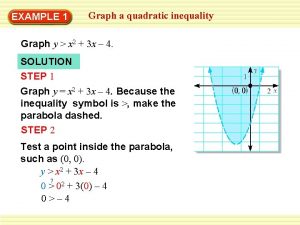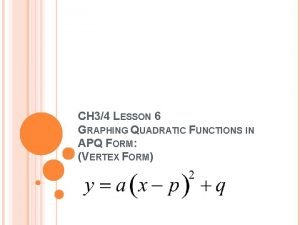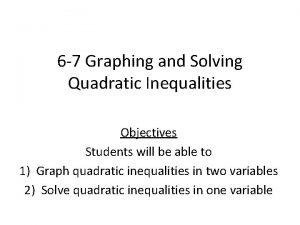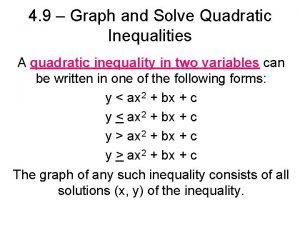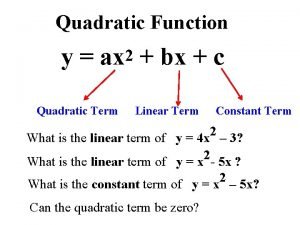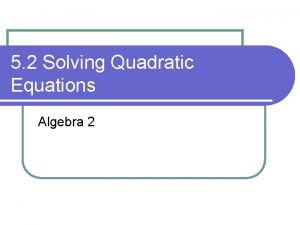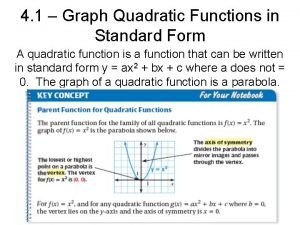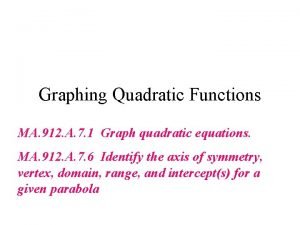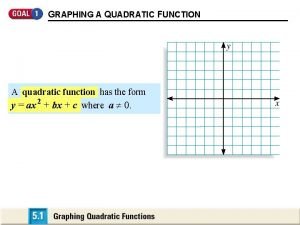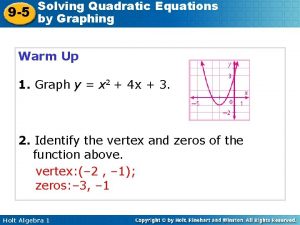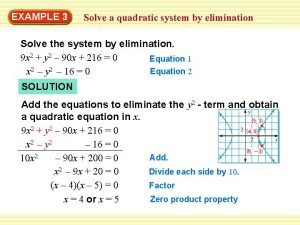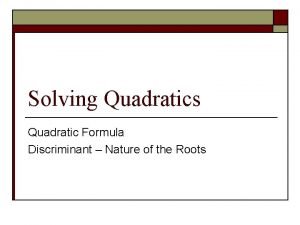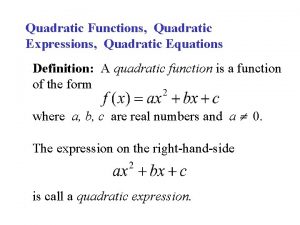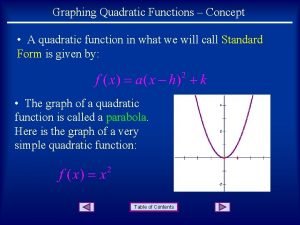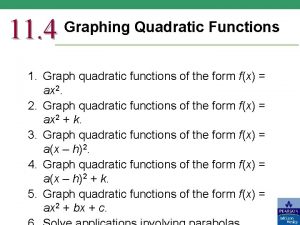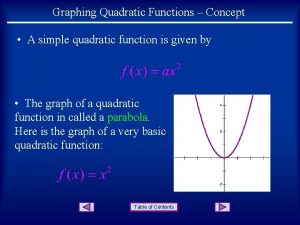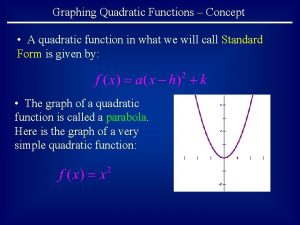Over Chapter 8 Over Chapter 8 Graphing Quadratic












































- Slides: 44

Over Chapter 8

Over Chapter 8

Graphing Quadratic Functions Lesson 9 -1

Understand how analyze the characteristics of and graph quadratic functions




y-intercept, c x = -b/(2 a) vertex

Graph a Parabola Use a table of values to graph y = x 2 – x – 2. State the domain and range. Graph these ordered pairs and connect them with a smooth curve. Answer: domain: all real numbers;

Use a table of values to graph y = x 2 + 2 x + 3. A. B. C. D.

Identify Characteristics from Graphs A. Find the vertex, the equation of the axis of symmetry, and y-intercept of the graph. Step 1 Find the vertex. (2, – 2). Step 2 Find the axis of symmetry. x = 2. Step 3 Find the y-intercept is 2. Answer: vertex: (2, – 2); axis of symmetry: x = 2; y-intercept: 2

Identify Characteristics from Graphs B. Find the vertex, the equation of the axis of symmetry, and y-intercept of the graph. Step 1 Find the vertex. maximum point (2, 4). Step 2 Find the axis of symmetry. x = 2. Step 3 Find the y-intercept is – 4. Answer: vertex: (2, 4); axis of symmetry: x = 2; y-intercept: – 4

A. Consider the graph of y = 3 x 2 – 6 x + 1. Write the equation of the axis of symmetry. A. x = – 6 B. x = 6 C. x = – 1 D. x = 1

B. Consider the graph of y = 3 x 2 – 6 x + 1. Find the coordinates of the vertex. A. (– 1, 10) B. (1, – 2) C. (0, 1) D. (– 1, – 8)

Identify Characteristics from Functions A. Find the vertex, the equation of the axis of symmetry, and y-intercept of y = – 2 x 2 – 8 x – 2. Formula for the equation of the axis of symmetry a = – 2, b = – 8 Simplify.

Identify Characteristics from Functions The equation for the axis of symmetry is x = – 2. To find the vertex, use the value you found for the axis of symmetry as the x-coordinate of the vertex. To find the y-coordinate, substitute that value for x in the original equation y = – 2 x 2 – 8 x – 2 Original equation = – 2(– 2)2 – 8(– 2) – 2 x = – 2 =6 Simplify. The vertex is at (– 2, 6). The y-intercept occurs at (0, c). So, the y-intercept is – 2.

Identify Characteristics from Functions Answer: vertex: (– 2, 6); axis of symmetry: x = – 2; y-intercept: – 2

Identify Characteristics from Functions B. Find the vertex, the equation of the axis of symmetry, and y-intercept of y = 3 x 2 + 6 x – 2. Answer: vertex: (– 1, – 5); axis of symmetry: x = – 1; y-intercept: – 2

A. Find the vertex for y = x 2 + 2 x – 3. A. (0, – 4) B. (1, – 2) C. (– 1, – 4) D. (– 2, – 3)

B. Find the equation of the axis of symmetry for y = 7 x 2 – 7 x – 5. A. x = 0. 5 B. x = 1. 5 C. x = 1 D. x = – 7


Maximum and Minimum Values A. Consider f(x) = –x 2 – 2 x – 2. Determine whether the function has a maximum or a minimum value. For f(x) = –x 2 – 2 x – 2, a = – 1, b = – 2, and c = – 2. Answer: Because a is negative the graph opens down, so the function has a maximum value.

Maximum and Minimum Values B. Consider f(x) = –x 2 – 2 x – 2. State the maximum or minimum value of the function. The maximum value is the y-coordinate of the vertex. The x-coordinate of the vertex is f(x) = –x 2 – 2 x – 2 or – 1. Original function f(– 1) = –(– 1)2 – 2(– 1) – 2 x = – 1 f(– 1) = – 1 Simplify. Answer: The maximum value is – 1.

Maximum and Minimum Values C. Consider f(x) = –x 2 – 2 x – 2. State the domain and range of the function. Answer: The domain is all real numbers. The range is all real numbers less than or equal to the maximum value, or {y | y – 1}.

A. Consider f(x) = 2 x 2 – 4 x + 8. Determine whether the function has a maximum or a minimum value. A. maximum B. minimum C. neither

B. Consider f(x) = 2 x 2 – 4 x + 8. State the maximum or minimum value of the function. A. – 1 Step 1 Find the axis of symmetry B. 1 Step 2 Find the value of y at the vertex C. 6 D. 8

C. Consider f(x) = 2 x 2 – 4 x + 8. State the domain and range of the function. A. Domain: all real numbers; Range: {y | y ≥ 6} B. Domain: all positive numbers; Range: {y | y ≤ 6} C. Domain: all positive numbers; Range: {y | y ≥ 8} D. Domain: all real numbers; Range: {y | y ≤ 8}


Graph Quadratic Functions Graph the function f(x) = –x 2 + 5 x – 2. Step 1 Find the equation of the axis of symmetry. Formula for the equation of the axis of symmetry a = – 1 and b = 5 or 2. 5 Simplify.

Graph Quadratic Functions Step 2 Find the vertex, and determine whether it is a maximum or minimum. f(x) = –x 2 + 5 x – 2 Original equation = –(2. 5)2 + 5(2. 5) – 2 x = 2. 5 = 4. 25 Simplify. The vertex lies at (2. 5, 4. 25). Because a is negative the graph opens down, and the vertex is a maximum.

Graph Quadratic Functions Step 3 Find the y-intercept. f(x) = –x 2 + 5 x – 2 Original equation = –(0)2 + 5(0) – 2 x=0 = – 2 Simplify. The y-intercept is – 2.

Graph Quadratic Functions Step 4 The axis of symmetry divides the parabola into two equal parts. So if there is a point on one side, there is a corresponding point on the other side that is the same distance from the axis of symmetry and has the same y-value.

Graph Quadratic Functions Step 5 Answer: Connect the points with a smooth curve.

Graph the function f(x) = x 2 + 2 x – 2. A. B. C. D.

Use a Graph of a Quadratic Function A. ARCHERY Ben shoots an arrow. The path of the arrow can be modeled by y = – 16 x 2 + 100 x + 4, where y represents the height in feet of the arrow x seconds after it is shot into the air. Graph the height of the arrow. Equation of the axis of symmetry a = – 16 and b = 100

Use a Graph of a Quadratic Function The equation of the axis of symmetry is x = the x-coordinate for the vertex is y = – 16 x 2 + 100 x + 4 . Original equation Simplify. The vertex is at . Thus, .

Use a Graph of a Quadratic Function Let’s find another point. Choose an x-value of 0 and substitute. Our new point is (0, 4). The point paired with it on the other side of the axis of symmetry is

Use a Graph of a Quadratic Function Repeat this and choose an x-value to get (1, 88) and its corresponding point and create a smooth curve. Answer: Connect these with points

Use a Graph of a Quadratic Function B. ARCHERY Ben shoots an arrow. The path of the arrow can be modeled by y = – 16 x 2 + 100 x + 4, where y represents the height in feet of the arrow x seconds after it is shot in the air. At what height was the arrow shot? The arrow is shot when the time equals 0, or at the y-intercept. Answer: The arrow is shot when the time equal 0, or at the y-intercept. So, the arrow was 4 feet from the ground when it was shot.

Use a Graph of a Quadratic Function C. ARCHERY Ben shoots an arrow. The path of the arrow can be modeled by y = – 16 x 2 + 100 x + 4, where y represents the height in feet of the arrow x seconds after it is shot in the air. What is the maximum height of the arrow? The maximum height of the arrow occurs at the vertex.

A. TENNIS Ellie hit a tennis ball into the air. The path of the ball can be modeled by y = –x 2 + 8 x + 2, where y represents the height in feet of the ball x seconds after it is hit into the air. Graph the path of the ball. A. B. C. D.

B. TENNIS Ellie hit a tennis ball into the air. The path of the ball can be modeled by y = –x 2 + 8 x + 2, where y represents the height in feet of the ball x seconds after it is hit into the air. At what height was the ball hit? A. 2 feet B. 3 feet C. 4 feet D. 5 feet

C. TENNIS Ellie hit a tennis ball into the air. The path of the ball can be modeled by y = –x 2 + 8 x + 2, where y represents the height in feet of the ball x seconds after it is hit into the air. What is the maximum height of the ball? A. 5 feet B. 8 feet C. 18 feet D. 22 feet

Homework Day 1 p 550 #23 -57 odd Day 2 p 551 #59 -67 odd, Word Problem Practice 9 -1
 9-5 solving quadratic equations by graphing
9-5 solving quadratic equations by graphing 9-5 solving quadratic equations by graphing
9-5 solving quadratic equations by graphing Objectives of quadratic equation
Objectives of quadratic equation Graphing quadratic inequalities
Graphing quadratic inequalities 8-3 graphing quadratic functions
8-3 graphing quadratic functions How to solve quadratic function graph
How to solve quadratic function graph Quadratic inequalities shading
Quadratic inequalities shading Standard form y=ax^2+bx+c
Standard form y=ax^2+bx+c Example of quadratic inequality graph
Example of quadratic inequality graph 9-1 practice graphing quadratic functions
9-1 practice graphing quadratic functions Vertex x coordinate
Vertex x coordinate 5-2 solving quadratic equations by graphing
5-2 solving quadratic equations by graphing 9-1 graphing quadratic functions
9-1 graphing quadratic functions How to solve quadratic inequalities algebraically
How to solve quadratic inequalities algebraically System of quadratic inequalities
System of quadratic inequalities How to find roots of equation
How to find roots of equation 4-1 graphing quadratic functions
4-1 graphing quadratic functions Y=ax^2+bx+c
Y=ax^2+bx+c 9-3 graphing quadratic functions
9-3 graphing quadratic functions 9-1 graphing quadratic functions answer key
9-1 graphing quadratic functions answer key Lesson 8-1 identifying quadratic functions
Lesson 8-1 identifying quadratic functions What is the vertex form of a quadratic equation
What is the vertex form of a quadratic equation Quadratic inequalities shading
Quadratic inequalities shading 5-2 solving quadratic equations by graphing
5-2 solving quadratic equations by graphing How to convert y=a(x-h)^2+k into y=ax2+bx+c
How to convert y=a(x-h)^2+k into y=ax2+bx+c Solving graphing and analyzing quadratic functions
Solving graphing and analyzing quadratic functions 4-1 graphing quadratic functions
4-1 graphing quadratic functions Standard form from graph
Standard form from graph What does b represent in y=ax^2+bx+c
What does b represent in y=ax^2+bx+c Graphing a quadratic function
Graphing a quadratic function 9-5 solving quadratic equations by graphing
9-5 solving quadratic equations by graphing 9-1 practice graphing quadratic functions
9-1 practice graphing quadratic functions Quadratic formula vocabulary words
Quadratic formula vocabulary words Quadratic quadratic systems examples
Quadratic quadratic systems examples The discriminant of the quadratic equation
The discriminant of the quadratic equation Chapter 16.4 measuring and recording respirations
Chapter 16.4 measuring and recording respirations Chapter 3 graphing linear functions answer key
Chapter 3 graphing linear functions answer key Chapter 14:3 measuring and recording pulse
Chapter 14:3 measuring and recording pulse Over the mountains over the plains
Over the mountains over the plains Siach reciting the word over and over
Siach reciting the word over and over Taking over navigational watch
Taking over navigational watch Bounded or unbounded graph
Bounded or unbounded graph Writing and graphing inequalities
Writing and graphing inequalities How to go from standard form to vertex form
How to go from standard form to vertex form Desmos graphing
Desmos graphing

